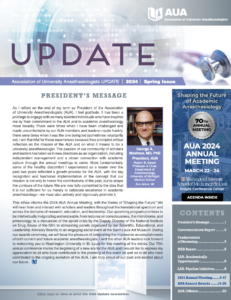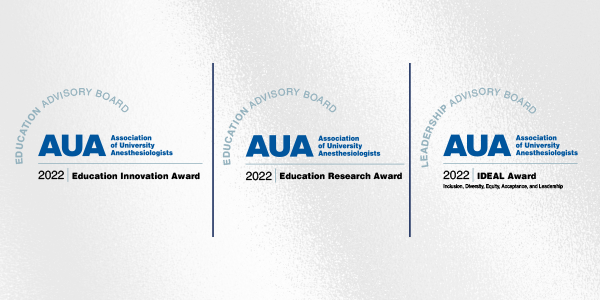Enhancing Resilience to Decrease Burnout: One Piece of the Wellness Equation
The Burnout Epidemic
The topic of physician burnout has received increasing national attention over the last decade. A 2008 study of medical students at 7 U.S. medical schools revealed that approximately 50% of medical students experience burnout and 10% experience suicidal ideation during medical school.1 The first large-scale, multi-specialty study of burnout in U.S. physicians was conducted in 2011. Using the Maslach Burnout Inventory as the assessment tool, the authors found that 46% of physicians had at least one symptom of burnout. The four specialties with the highest rates of burnout were emergency medicine, general internal medicine, neurology, and family medicine (anesthesiology was seventh on the list).2 A follow-up study in 2014 demonstrated an increased rate of burnout among U.S. physicians, with over half (54%) reporting at least one symptom of burnout. By contrast, a sample of the general U.S. working population had an unchanged incidence of burnout between 2011 and 2014 (approximately 28%).3
Burnout is defined as a work-related psychological syndrome with three components: emotional exhaustion, depersonalization (including cynicism), and a decreased sense of personal accomplishment and value of one’s own work.4 Several conceptual models of the development of burnout have been described. In one model, job stress results from an imbalance between work demands and individual resources. Subsequently, the individual experiences strain, an emotional response characterized by exhaustion and anxiety. This leads to defensive coping, including a change in attitude and behavior, such as increased cynicism.
Many factors in our current healthcare environment play a role in physician burnout. Electronic medical records, demanding caseloads, increased regulatory pressure, decreased insurance reimbursements, increased administrative tasks, growing health systems and a constant influx of new medical knowledge, technologies and practices cause individual, departmental and institutional pressure.5,6 Furthermore, physicians have historically been reluctant to admit any emotional or psychological weaknesses. The perceived stigma about our own mental health often poses a barrier to treatment. In some cases, concern about documentation of mental health issues poses an obstacle as well. For example, in some states physicians must disclose to the licensing board whether they have been treated for a mental illness.6 Physicians who do not seek help place themselves at even greater risk of burnout.
Anesthesiologists may be at higher risk of burnout due to the stressful nature of their work and the fast-paced environments in which they practice. Several studies have shown higher rates of emotional exhaustion and depersonalization among anesthesiologists compared with other providers.7-9
Resilience and Prevention of Burnout
Wellness, which can be defined as a state of physical, mental, and social well-being, is a dynamic process that involves growth and change. Many efforts to promote wellness and decrease physician burnout have focused on building resilience.5 Resilience itself is often defined as the ability of an individual to maintain emotional and social stability despite adversity. Resilience was once viewed as a trait that was immutable – either you had it or you didn’t. However, increasing evidence suggests that resilience is a process, with a skill set that can be learned.5 Resilience includes two activities: prevention and correction. Preventive activities help to deter adverse situations; corrective actions are used to cope effectively under difficult circumstances.
Several factors contribute to a person’s own resiliency. These may include a combination of spiritual, emotional, social, physical, and cognitive conditions that make up our overall state of being. Table 1 outlines some practices that lead to enhanced resilience within these different domains.
Table 1
| Domain | Activities to promote resilience |
|---|---|
| Spiritual | Self-compassion, recognizing a common humanity, finding meaning in work, spiritual/religious practices |
| Emotional | Processing grief, setting boundaries, positive experiences of pro-social emotions (i.e. gratitude, empathy, appreciation) |
| Social | Support, sharing, building community |
| Physical | Exercise, proper nutrition, rest/sleep |
| Cognitive | Reflection, mindfulness practice |
Most studies of resilience in physicians have focused on a small sample size and a few specialties. In one of the larger studies, 74 internal medicine physicians were randomly assigned to receive a one-hour facilitated small group discussion every 2 weeks for nine months on subjects that included meaning in work, personal and professional balance, community, and medical mistakes. The control group was given the same amount of time to be used in an unstructured manner. The study group had an improvement in measures of meaning and engagement in work and reduced depersonalization, with these improvements sustained 12 months after study completion.10
A 2013 study analyzed the resilience strategies of 200 experienced physicians of a variety of ages, specialties, and hierarchical status. The participants, who did not display burnout on the Maslach Burnout Inventory, underwent a semi-structured interview that focused on the main research question: “Which strategies do you apply to deal with the stressors of your professional life?” Content analysis of the interviews revealed three themes: general sources of gratification, behavioral routines and practices, and attitudes and mental strategies. Table 2 lists the 7 resilience strategies used by the majority of study participants.11
Table 2 (adapted from Zwack et al., 2013)
| Theme | Resilience strategy | Comment |
|---|---|---|
| General sources of gratification | Gratification from doctor-patient relationship | Efficacy in the immediate doctor-patient relationship viewed as crucial part of professional activity |
| Gratification from medical efficacy | Efficacy could be related to symptoms before and after care, complex diagnostic issue that was solved, and treatment success, whether large or small in magnitude. | |
| Behavioral routines and practices | Leisure-time activity | Examples include physical activity to reduce stress and facilitate change in mental focus, and cultural activity (e.g., music, art) to broaden horizons and provide perspective |
| Quest for and cultivation of contact with colleagues | Useful as a means to reduce professional insecurity, as a source for increased professional knowledge, and to provide mutual support | |
| Cultivation of relations with family and friends | Provide source of stability, understanding, and perspective | |
| Attitudes and mental strategies | Acceptance and realism | Most important resilience-promoting attitude was ability to refrain from wishful thinking and accept external realities. |
| Self-awareness and reflection | Awareness of one’s professional proficiency and ability to prompt self-reflection were significant factors promoting resilience |
There were 23 other resilience strategies used by a significant number of other physicians in the study.11 Clearly, there is no “one size fits all” approach to building resilience. In an effort to improve physician burnout rates, resilience strategies should be taught and practiced at all levels of training and throughout our careers.5,10-12
Beyond Resilience
Physicians have a responsibility to enhance our own resilience by building on sound practices that promote our internal sense of well-being. However, there are enormous demands from the external systems in which we work that must be recognized.6 Departments, institutions, and health care systems must acknowledge that physician burnout is a significant threat to sustainability due to its potential impact on cost, quality and safety.13,14 Leaders at all levels must work in collaboration with physicians to find ways to improve work-flow, elevate job satisfaction, and promote wellness. A 2015 study showed that the leadership qualities of physician supervisors directly impact the personal well-being and satisfaction of the physicians they lead.15 Employing highly effective leaders who are well versed in the concepts of physician burnout and well-being is essential. Recognizing the importance of this, Stanford Medicine recently hired a chief wellness officer to run their innovative wellness center. National institutions have also shown dedication to the cause. The National Academy of Medicine recently launched the Action Collaborative on Clinician Well-being and Resilience. Over the next few years the Action Collaborative will work to identify evidence-based strategies to improve clinician well-being at both individual and systems levels. Finally, in 2017 the Institute for HealthCare Improvement (IHI) published a paper outlining the four steps leaders can take to help restore joy to the healthcare workforce. The IHI stresses that joy in work is more than the absence of burnout or an issue of individual wellness but rather the responsibility of the system as a whole.16 The burnout and wellness crisis cannot be fixed simply by enhancing physician resilience. Over the next several years, departments, organizations, and institutions must work together to find ongoing solutions to this healthcare epidemic.
References
- Dyrbye LN, Thomas MR, Massie FS, Power DV, Eacker A, Harper W, Durning S, Moutier C, Szydlo DW, Novotny PJ, Sloan JA, Shanafelt TD. Burnout and Suicidal Ideation among U.S. Medical Students. Ann Intern Med. 2008; 149(5): 334-341.
- Shanafelt T, Boone S, Tan L. Burnout and Satisfaction with Work-Life Balance Among US Physicians Relative to the General US Population. Arch Int. Med. 2012; 172(18):1377-1385.
- Shanafelt TD, Hasan O, Dyrbye LN, Sinsky C, Satele D, Sloan J, West CP. Changes in Burnout and Satisfaction With Work-Life Balance in Physicians and the General US Working Population Between 2011 and 2014. Mayo Clin Proc. 2015; 90(12):1600-13.
- Maslach, C and Leiter, M. Understanding the burnout experience: recent research and its implications for psychiatry. World Psychiatry 2016; 15:103-111.
- Beresin EV, Milligan TA, Balon R, Coverdale JH, Louie AK, Roberts, LW. Physician Wellbeing: A Critical Deficiency in Resilience Education and Training. Acad Psychiatry 2016; 40: 9-12.
- Kuhn CM, Flannagan EM. Self-care as a professional imperative: physician burnout, depression, and suicide. Can J Anaesth. 2017; 64(2):158-168.
- De Oliveira GS Jr, Ahmad S, Stock MS, Harter RL, Almeida MD, Fitzgerald PC, McCarthy RJ. High incidence of burnout in academic chairs of anesthesiology: Should we be taking better care of our leaders? Anesthesiology 2011; 114:181–93.
- Hyman SA, Michaels DR, Berry JM, Schildcrout JS, Mercaldo ND, Weinger MB. Risk of burnout in perioperative clinicians: A survey study and literature review. Anesthesiology 2011; 114:194–204.
- Hyman, SA, Shotwell MS, Michaels DR, Han X, Card EB, Morse JL, Weinger MB. A Survey Evaluating Burnout, Health Status, Depression, Reported Alcohol and Substance Use, and Social Support of Anesthesiologists. Anesth Analg. 2017; 125(6):2009-2018.
- West CP, Dyrbye LN, Rabatin JT, Call TG, Davidson JH, Multari A, Romanski SA, Hellyer JM, Sloan JA, Shanafelt TD. Intervention to promote physician well-being, job satisfaction, and professionalism: a randomized clinical trial. JAMA Intern Med. 2014; 174(4):527-33.
- Zwack J, Schweitzer J: If every fifth physician is affected by burnout, what about the other four? Resilience strategies of experienced physicians. Acad Med. 2013 Mar;88(3):382-9.
- Eckleberry-Hunt J, Van Dyke A, Lick D, Tucciarone J. Changing the Conversation From Burnout to Wellness: Physician Well-being in Residency Training Programs. J Grad Med Educ. 2009; 1(2): 225–230.
- Shanafelt T, Goh J, Sinsky C. The Business Case for Investing in Physician Well-being. JAMA Internal Medicine 2017; 177: 1826-1832.
- Salyers MP, Bonfils KA, Luther L, Firmin RL, White DA, Adams EL, Rollins AL. The Relationship Between Professional Burnout and Quality and Safety in Healthcare: A Meta-Analysis. J Gen Intern Med. 2017; 32(4):475-482.
- Shanafelt TD, Gorringe G, Menaker R, Storz KA, Reeves D, Buskirk SJ, Sloan JA, Swensen SJ. Impact of organizational leadership on physician burnout and satisfaction. Mayo Clin Proc. 2015 Apr; 90(4):432-40.
- IHI Perlo J, Balik B, Swensen S, Kabcenell A, Landsman J, Feeley D. IHI Framework for Improving Joy in Work. IHI White Paper. Cambridge, Massachusetts: Institute for Healthcare Improvement; 2017.












